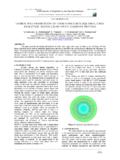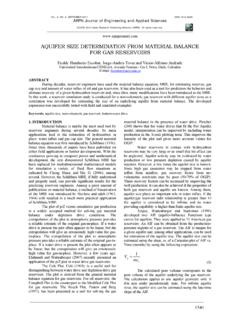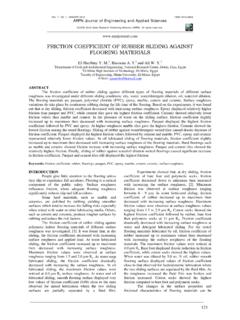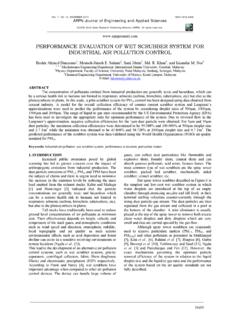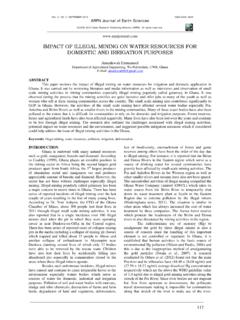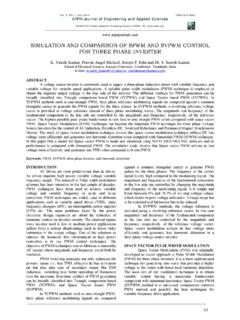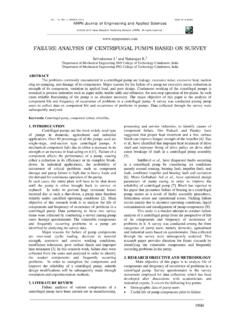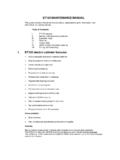Transcription of INVESTIGATION OF FLOW DURING INTAKE …
1 VOL. 7, NO. 2, FEBRUARY 2012 ISSN 1819-6608 ARPN Journal of Engineering and Applied Sciences 2006-2012 Asian Research Publishing Network (ARPN). All rights reserved. 180 INVESTIGATION OF FLOW DURING INTAKE STROKE OF A SINGLE CYLINDER INTERNAL COMBUSTION ENGINE C. Ramesh Kumar1 and G. Nagarajan2 1 CEAR, School of Mechanical and Building Sciences, VIT University, Vellore, India 2 CEG, Anna University, Chennai, India E-Mail: ABSTRACT This paper deals with experimental INVESTIGATION of swirling flow in the cylinder of a spark ignited engine. The variations in different non-dimensional parameters such as Flow Coefficient, Swirl Coefficient and Swirl Ratio at various valve lifts and throttle opening was studied using a steady flow bench.
2 The swirl enhancement using valve shrouding, and twisted tape insert was also investigated. The results indicate that a higher swirl coefficient and swirl ratio can be achieved with shrouded valve and twisted tape with penalty on flow coefficient. These experimental results can be utilized to verify the results of modeling using commercial CFD codes and also for increasing the accuracy of mathematical modeling of combustion process in internal combustion engines. Keywords: internal combustion engine, swirl enhancement, flow coefficient, swirl coefficient. 1. INTRODUCTION The INVESTIGATION of in-cylinder flow motion has gained its importance ever since impose of regulatory emission norms. Air motion into the cylinder DURING the INTAKE stroke of an internal combustion engine is one of the important factors, which governs the performance of an engine.
3 Improvements in engine efficiency can also be attained by enhanced in-cylinder flow motions using optimized cylinder head, port and valve timing. A well-designed INTAKE manifold and cylinder head will reduce the flow resistance and increases the swirl. Swirl is the rotation of charge about cylinder axis and it is used in SI engines to speed up the combustion process and in the diesel engines to control the air-fuel mixing [1]. Two general approaches are used to create swirl DURING the induction process. In first approach, swirl is created by discharging the flow into the cylinder tangentially towards the cylinder wall (helical port) and in the second approach, the swirl is generated in the manifold runner so that the flow rotates about the valve axis before it enters the cylinder.
4 Several research studies related to swirl enhancement in IC engines reported that swirl facilitates the mixing of the air fuel mixture and increases the combustion rate. The experimental work of Sihun Lee et al., [2] showed that both swirl and tumbling motions enhanced the fuel vaporization and fuel-air mixing and results in better cold start performance. Another advantage that was reported was ability to retard ignition timing as it has faster burning, which gives enough time for fuel vaporization and fuel-air mixing before being ignited. Taehoon Kim et al., [3] improved the lean misfire limit by the introduction of swirl and tumble motion.
5 Three types of ports with an IACV ( INTAKE Air Control Valve) have been developed to obtain sufficient swirl and tumble motion to improve combustion and still keep high volumetric efficiency. Tests showed that the combustion duration was shortened and consequently lean misfire limit and EGR tolerance were improved with considerable reduction in the level of NOx. J. H. Whitelaw and H. M. Xu [4] measured the cylinder pressure and flame travel velocity in a single cylinder engine with two arrangements of port geometry and with mixture equivalence ratios from to The INVESTIGATION compares the combustion processes in terms of the maximum pressure, flame speed and in cylinder flow velocity without and with an INTAKE valve shroud which increased both the tumble and swirl ratios.
6 The photographic studies confirm the dominant effect of the swirling flow on flame propagation and deviations of the flame kernel from spherical as the air-fuel ratio is increased, with much higher probability of influence of velocity fluctuations. Abdul Rahim Ismail et al., [5] in their experiment investigated air flow and coefficient of discharge desirable for inflow (reverse flow) through the exhaust port using super flow bench. The experimental results show that the air flow and coefficient of discharge in the INTAKE port and exhaust port of the four stroke diesel engine provided the best at L / D and in highest test pressure. Increasing the valve lift and test pressure can increase the air flow, valve air flow and coefficient of discharge in INTAKE manifold system or in exhaust manifold system, but after the maximum valve lift per diameter / D, the air flow, valve air flow and coefficient of discharge is stable and did not increase.
7 Tomonori Urushihara et al., [6] studied the flow measurements for various types of INTAKE systems that generated several different combinations of swirl and tumble ratios using laser doppler velocimetry and visualization of in-cylinder fuel vapour motion by laser induced fluorescence. It was concluded that a low tumble ratio is a necessary condition for obtaining axial mixture stratification in the cylinder and Strong swirl, which has been considered to be necessary for axial mixture stratification, is not always effective in stratifying the mixture. Swirl at the end of compression and beginning of combustion will break into turbulence motion due to upward motion of the piston.
8 Higher level of swirl does not improve the combustion and emission; instead it VOL. 7, NO. 2, FEBRUARY 2012 ISSN 1819-6608 ARPN Journal of Engineering and Applied Sciences 2006-2012 Asian Research Publishing Network (ARPN). All rights reserved. 181reduces the volumetric efficiency as swirl created reduces the kinetic energy of the flowing fluid. The steady state flow analysis helps to find variations in different non-dimensional parameters such as Coefficient of Discharge, Flow Coefficient, Swirl Coefficient and Swirl Ratio for various valve lifts and it also helps in identifying the flow structure within the cylinder.
9 The main objective of this work was to investigate the bulk swirling charge motion inside the cylinder with and without flow modifications in a small utility engine. Flow modification was carried out in two methods, by using a twisted tape in the manifold and shrouding the inlet valve. 2. MATERIALS AND METHODS Flow benches and particle image velocimetry (PIV) are the two methods commonly utilized to measure the momentum and flow structure of an in-cylinder flow field. Steady flow setups are simple, inexpensive and provide an approximate value of angular momentum. A flow analysis was carried out on a flow bench fitted with flow meter, digital micro-manometer, thermocouples, paddle wheel and angle encoder to measure different non-dimensional parameters such as Flow Coefficient and Swirl Coefficient at various valve lifts using a baseline unmodified cylinder head and cylinder head with shrouded valve attachment, and twisted tape.
10 A test rig with vane type (paddle wheel) swirl flow meter was used for measuring the swirl. An acrylic tube of diameter similar to that of engine cylinder was used. A flow straightener was connected to the INTAKE side of the cylinder head to ensure laminar flow to the cylinder head. An orifice plate was used to measure the air mass flow rate. A blower of 16000 rpm, 600W, and m3 / min discharge rate is used to induct air through the INTAKE valve in order to simulate the actual engine operating condition. Air was sucked through the head and INTAKE port configuration. To measure the pressure drop, micro-manometer with selection switch is used. Fixed pressure drop ( P) of kPa across inlet valve and cylinder was maintained at all valve lifts.
